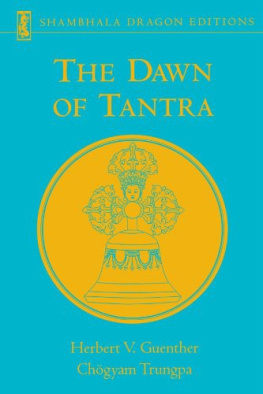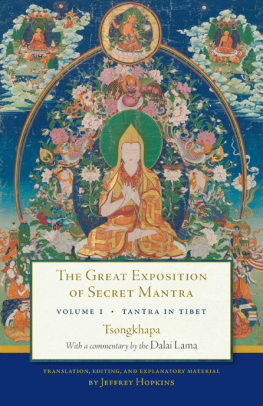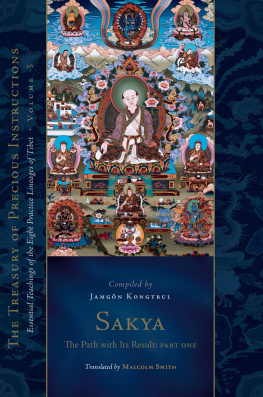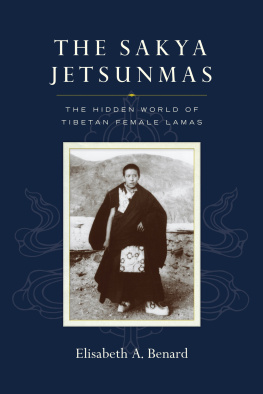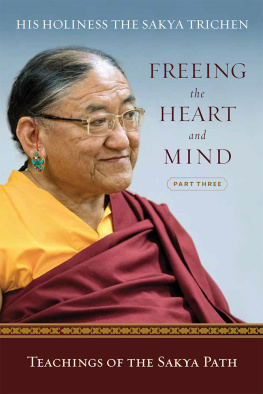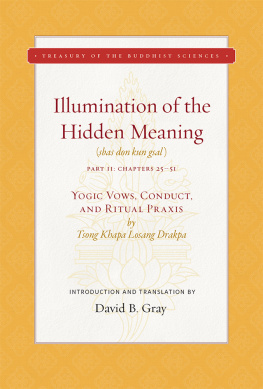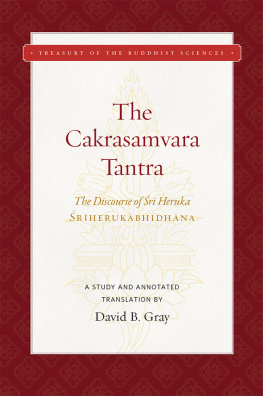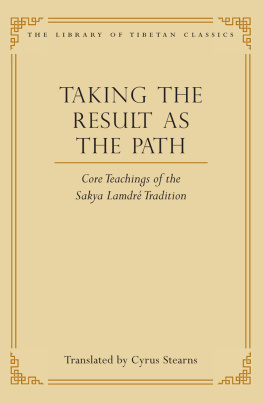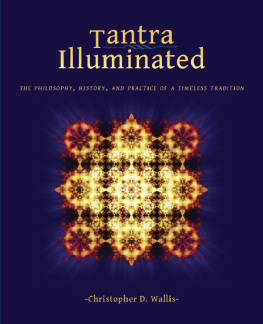Classics of the Early Sakya, Volume 1
The Yoginis Eye
Comprehensive Introduction
to Buddhist Tantra
Volume 1: Systemization and Interpretation
by Sonam Tsemo
as supplemented with the writings of the later Sakya lineage
translated by
Ngor Thartse Khenpo Sonam Gyatso (Hiroshi Sonami)
and
Wayne Verrill
Copyright 2012 by Wayne Verrill.
Library of Congress Control Number: | 2012913509 |
ISBN: | Hardcover | 978-1-4771-5045-0 |
Softcover | 978-1-4771-5044-3 |
All rights reserved. No part of this book may be reproduced or transmitted in any form or by any means, electronic or mechanical, including photocopying, recording, or by any information storage and retrieval system, without permission in writing from the copyright owner.
To order additional copies of this book, contact:
Xlibris Corporation
1-888-795-4274
www.Xlibris.com
108424
Contents
To the memory of Nai-yuine Ding
Classics of the Early Sakya Series
The Yoginis Eye : Comprehensive Introduction to Buddhist Tantra, Volume 1: Systemization and Interpretation by Sonam Tsemo (1142-1182) introduces a new series of translations called Classics of the Early Sakya . This series will include the major writings on the Hevajra Tantra cycle by the first three of the Five Founders of the Sakya lineage: Kunga Nyingpo (1092-1158), Sonam Tsemo, and Drakpa Gyaltsen (1147-1216). The three early Sakyapas were responsible for the introduction into Tibet of many major cycles of tantric practice that are still major practices today including Chakrasamvara, Vajrayogini, and Twenty-One Taras. Yet most important of all to the early Sakyapas was the Hevajra Tantra cycle of practice, which is reflected in the first five volumes of this new series.
This first volume in the series, The Yoginis Eye , has been since its composition and still is the introductory text for the study of the Sakya tantra system. In this capacity, The Yoginis Eye is included in volume 1 of the Lamdre Tshokshe ( Path and Result Teachings for the Assembly ) Tradition of the Sakya Lamdre (volume 21 of the Lamdre Literature Series ) as the most comprehensive and systematic introduction to all Buddhist Tantra, as practiced by the Sakya as well as other lineages.
The second volume in the series will be The Precious Tree : Comprehensive Introduction to Buddhist Tantra , Volume : Direct Knowledge through Practice , written by Sonam Tsemos younger brother, Drakpa Gyaltsen, completing the task that Sonam Tsemo initiated but was unable to complete during his lifetime. This second book and its most extensive commentary, written by Konchok Lhundrup (1497-1547), comprise the entire volume 2 of the Lamdre Tshokshe (volume 22 of the Lamdre Literature Series ), and the entire volume 28 of the Gyude Kuntu .
The third volume in the series will initiate the complete word-by-word explanations of the source Tantras , beginning with Drakpa Gyaltsens commentary on the Hevajra Tantra itself, together with annotations by Jamyang Loter Wangpo, comprising most of volume 3 of the Lamdre Tshokshe (volume 23 of the Lamdre Literature Series ), and volume 29 of the Gyude Kuntu , as well as references to other Sakya commentaries, including that of Sonam Tsemo.
The fourth volume in the series will be Drakpa Gyaltsens commentary on the Vajra Panjara ( Vajra Canopy ) Tantra .
The fifth volume in the series will be Sonam Tsemos commentary on the Samputa ( Perfect Union ) Tantra .
Substantial work has already been done on most of the forthcoming volumes, which will be completed in as timely a fashion as possible if health, personal funds, and life span of the present translator allow. Please note that all volumes in this series will be available to all sincere readers without restriction, in order to fulfill the bodhisattva vow to be of most benefit to all sentient beings without presumption or prejudice, and thereby access will not be limited to a privileged few.
Sonam Tsemo, Author of Volume 1
Only a small amount of information is known about the life of Sonam Tsemo, the author of The Yoginis Eye . The best compilation of biographical material has been prepared by Ronald Davidson., when Sonam Tsemo was age twenty-seven. In the third period of his life from 1169 until his own death in 1182 at age forty, Sonam Tsemo returned to Sakya and composed most of his books and other writings, as he worked to expand on his fathers legacy.
Other major writings by Sonam Tsemo include the first complete Sakya manuals for the Hevajra empowerment and practice, the Treatise on Gateway to the Dharma ,
The Yoginis Eye: Comprehensive Introduction
to Buddhist Tantra
As far as is presently known, The Yoginis Eye : Comprehensive Introduction to Buddhist Tantra was the first truly comprenhensive book ever written on this subject. No book as comprehensive was ever known to have been written in Sanskrit in India. Four examples of relatively short books written in Tibetan covering some of the same topics are known to predate The Yoginis Eye . In the Sakya lineage, Ngari Salway Nyingpo wrote a book entitled The Lamp that Illuminates the Vehicles Common to Tantra , The content of Sachen Kunga Nyingpos Brief General Introduction formed the basis for part 1, chapters 1-4 and 6 of The Yoginis Eye where the subject matter is greatly expanded. No material pertinent to part 1, chapters 5 and 7, nor parts 2 and 3, appear in Sachen Kunga Nyingpos short book.
A book with the same title as on Sonam Tsemos initial title page, General Introduction to Tantra , is attributed to the early translator and Guhyasamaja Tantra lineage teacher Khukpa Lhetse,
Some doubt may be engendered as to the actual title of this present book by Sonam Tsemo, as The Yoginis Eye does not appear on the title page of the Tibetan edition, nor for that matter does the subtitle Comprehensive Introduction . The actual title appears at the end of the book in the first line of the epilogue, a not unusual occurrence for a Tibetan book.
The Yoginis Eye was not finished by the time of Sonam Tsemos death in 1182. The major part 4 on the content of the three continuities with detailed explanations of direct knowledge of the practice of tantra may not have been started, and part 3 may not have been finished. The colophon states that Sakya Pandita was responsible for the final editing, adding clarification, and restructuring the chapters.
In the over eight hundred years since it was written, The Yoginis Eye : Comprehensive Introduction to Buddhist Tantra has served as the standard Sakya introductory textbook for the study and practice of Tantra. This is apparent by the large number of study guides to the book written over the intervening centuries by the foremost Sakya scholars of their time. The Yoginis Eye is the first of four basic texts that were required for study and memorization at Ngor monastery. Auspiciously, this commentary has just recently appeared in the vast holdings of the Tibetan Buddhist Resource Center (TBRC), where it was also initially misidentified.
The first specific reference in English to Sonam Tsemos The Yoginis Eye : Comprehensive Introduction to Buddhist Tantra that the present translator is aware of is in a translation by Jeffrey Hopkins published in 1977, where it is cited and referenced as a foil for Tsongkhapas interpretations. The downside is that none of them present Sonam Tsemos contributions in a complete and comprehensive manner; that absence has now been corrected, at least for The Yoginis Eye .
Early Sakya Transmission of the Tantras
In chapter 9 at the end of the book, Sonam Tsemo defends against claims of imitating others (specifically the Guhyasamaja Tantra lineage of Nagarjuna) by extolling the two sources for his Hevajra Tantra tradition, Virwapa (Virupa) and Dombi Heruka, continuing through subsequent lineage members until being combined into a single lineage by the Drokmi Translator Shakya Yeshe (997-1077), then continuing through to his father, Sachen Kunga Nyingpo. Regarding this lineage, Sonam Tsemo says that now today, when giving explanations of all the Hevajra Cycle Tantras translated by the Great Translator, one becomes as if the compiler of (all) Tantras, and that his instruction method based on these two combined lineages gives an explanation of Tantra that is an instruction method for all Guhyamantra. Sonam Tsemo implies that this cannot be accomplished by the Guhyasamaja Tantra lineage of Nagarjuna, which is understood through just sadhana instructions and analyzing writings of panditas, without the benefit of special lineage instructions.
Next page

